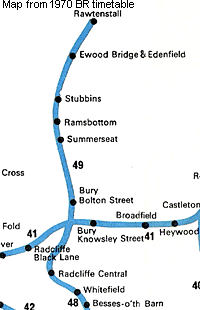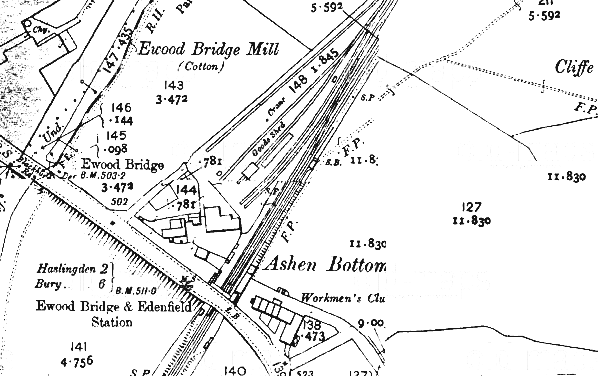Notes: Ewood Bridge & Edenfield Station was officially opened as Ewood Bridge on 25th September 1846, but public services began on 28th September. The station was situated on the East Lancashire Railway (ELR) company’s Clifton Junction to Rawtenstall line which opened on the same date.
The idea for a line between Clifton Junction and Rawtenstall via Bury dated back to a meeting on 24th September 1843, the outcome of which was the creation of the Manchester, Bury and Rossendale Railway (MB&RR). This company was formally incorporated on 4th July 1844. Whilst the line was under construction the MB&RR amalgamated with the Blackburn, Bury, Accrington & Colne Extension Railway, and on 21st July 1845 the new concern became the East Lancashire Railway.
 |
At the time of opening the line through Ewood Bridge was single track so the station was provided with one platform, on the east side of the line. A bridge carried Blackburn Road over the line at the station site. A two-storey stone building stood on the platform, immediately north of the road, to which was attached a single storey booking office at road-level. A small |
canopy gave some protection to passengers on the platform
The platform was mostly on the north side of the Blackburn Road bridge but a short length did continue under it and for several metres on the south side.
At the time of opening five passenger trains ran on weekdays in each direction between Manchester and Rawtenstall; there were four trains on Sundays.
On 17th August 1848 the ELR opened a route from Stubbins, just under two miles to the south of Ewood Bridge, to Accrington. This created a main line from Clifton Junction to Accrington reducing the Stubbins to Rawtenstall line, on which Ewood Bridge was located, to the status of a branch line. On 27th March 1848 the Stubbins to Rawtenstall line was extended northwards to Waterfoot and some four years later, on 1st October1852, to Bacup.
From July 1857 the line through Ewood Bridge was doubled and an extra platform was provided on the west side of the line. This became the northbound platform and, unlike the original - which became the southbound platform - it was located entirely on the north side of the Blackburn Road bridge. The new platform was reached by a set of steps down from the road at its southern end. The entrance gate to the new platform featured an archway, and a small, timber waiting shelter stood on the platform. On 13th May 1859 the Lancashire & Yorkshire Railway (LYR) absorbed the ELR.
 |
During the early years of LYR ownership passenger train services from Ewood Bridge continued to run to Manchester via Clifton Junction. In 1878 the LYR opened a signal box at the north end of the southbound platform. By this date goods facilities, which included five sidings and a goods shed and a 5-ton crane, had been developed on the west side of the line. The station did not handle livestock. There were also two private sidings nearby, Horncliffe and Irwell Vale which had its own 2-ton crane. From 1st September 1879 Ewood Bridge’s passenger services to and from Manchester were transferred south of Bury from the route via Clifton Junction to a new line via Prestwich.
In 1891/2 Ewood Bridge station was renamed Ewood Bridge & Edenfield.
In 1914 the LYR introduced a ‘Rail-motor’ service – known affectionately as ‘Little Billie’ - between Ramsbottom and Bacup; this called at all stations, including Ewood Bridge & Edenfield and supplemented trains that ran through to Manchester. From 11th April 1916 through passenger services to Manchester were diverted once more to travel via Heywood, adding a considerable mileage to their journeys. The reason for the change was that from this date electric services began on the Bury to Manchester (via Prestwich) line. Passengers for Manchester from Ewood Bridge & Edenfield were encouraged to change onto the electric trains at Bury for a quicker onward journey, and most of them did |
so. Within a few years many southbound services terminated at Bury Bolton Street.

|
On 1st January 1923 Ewood Bridge & Edenfield became part of the London Midland & Scottish Railway (LMS). By summer 1932 the station had fifteen services travelling northbound to Bacup on weekdays. The first service which had originated from Ramsbottom left at 6:13 am. The last service which had originated from Bury Bolton Street left Ewood |
Bridge & Edenfield for Bacup at 11:36 pm. Only four of the fifteen trains had originated from Manchester Victoria. Most had started at Bury Bolton Street, but one train had commenced its journey from Bury Knowsley Street and one from Bolton. Some services had started from Ramsbottom. On Tuesday and Fridays only there was an additional service to Bacup at 5:40 pm which originated at Ramsbottom.
Interestingly in the southbound direction there were twenty weekday departures, the first being for Middleton Junction at 05:36 am. The last train was for Bury Bolton Street and it left Ewood Bridge & Edenfield at 10:25 pm. The rest of the services tended to travel either to Manchester Victoria or Bury Bolton Street, but there were trains at 09:16, 10:36 and 3:11 which went to Bury Knowsley Street, as well as shorter workings to Ramsbottom. There was also a service from Bacup that terminated at Ewood Bridge & Edenfield at 08:19 am.
.gif) |
On 1st January 1948 Ewood Bridge & Edenfield became part of the nationalised British Railways (London Midland Region). In 1954 the line between Bury and Bacup was considered busy enough to warrant the introduction of modern rolling stock, and it was reported in the local press that new diesel multiple units (DMUs) were to be introduced; they entered service on the line in February 1956. Ewood Bridge & Edenfield had thirty-five trains in each direction, giving a half-hourly service: the most intensive that the line would see. In the 1950s the wooden waiting shelter on the Bacup platform was replaced with a brick-built structure. Closure of the goods yard took place on 2nd November 1959, and the signal box was decommissioned on 22nd July 1962
The purpose of Reshaping of British Railways(Beeching Report) of March 1963 was to create an economically viable network, involving the closure of many loss-making passenger lines and stations. The report’s proposals for Lancashire and north Manchester were astonishing. The entire route from Manchester via Bury Bolton Street to Bacup and
|
 |
Accrington was earmarked for closure, yet the nearby Manchester – Oldham – Rochdale and the Bolton – Bury Knowsley Street – Rochdale lines were not. The absurdity of withdrawing passenger services on the heavily used, electrified service between Manchester and Bury was acknowledged when, on 8th February 1965, the Minister of Transport refused consent to closure. However on 14th September 1966 the Minister gave permission for the Rawtenstall to Bacup and Bury to Accrington lines to close, which they did on 5th December 1966. (The final passenger train left Bacup on Saturday 3rd December.) Thereafter northbound trains from Ewood Bridge & Edenfield terminated at Rawtenstall. The service became a shuttle between Bury Bolton Street and Rawtenstall, and from 4th March 1968 all stations north of Bury became unmanned. The March 1967 timetable showed fifteen services in each direction at irregular intervals, and two extra workings on Saturdays, one in the early afternoon and another late at night. No trains ran on Sundays. In the final year’s timetable from May 1971 weekday services had been reduced to twelve in each direction, with thirteen on Saturdays, the late night Saturday working having ceased by May 1970.
 |
With effect from 19th April 1970 the line through Ewood Bridge & Edenfield became a single track branch. The southbound line through the station was lifted, and the northbound platform became bi-directional. The station's buildings on the southbound platform fell out of use and became derelict. On 5th June 1972 the service was withdrawn and Ewood Bridge & Edenfield station closed completely. The buildings were demolished. In 1976 both platforms remained, but the northbound one was subsequently demolished. Freight trains serving a coal depot at Rawtenstall continued to pass through the Ewood Bridge & Edenfield until 1980. On 28th March 1982 a railtour passed through, and after it had departed southwards the line was officially closed
A preservation group called the East Lancashire Railway after the original company entered into negotiations with British Rail with a view to reopening the line from Bury to Rawtenstall. |
Supported by the local authorities, they were successful and opened the stretch of line from Bury to Ramsbottom on 25th July 1987 and onward to Rawtenstall on 27th April 1991. Once again trains started to pass through the site of Ewood Bridge & Edenfield, but the station was not reopened. A section of its original platform, however, is in situ and has been repaired and cleared of vegetation.
Tickets from Michael Stewart , route map drawn by Alan Young, timetables from Alan Young
Click here to see of film of a train journey between Bury and Bacup in 1966
See also the Ramsbottom Model Railway Club web site which features 106 old photographs of the East Lancashire Railway and photographs of the clubs excellent layout of Ramsbottom & Stubbins.
Sources:
To see other stations on the East Lancashire Railway Clifton Junction - Bacup line click on the station name on the station name: Clifton Junction, Molyneux Brow, Ringley Road, Radcliffe Bridge, Withens Lane, Bury Bolton Street, Summerseat, Ramsbottom, Stubbins, Irwell Vale (new station on the ELR), Rawtenstall, Clough Fold, Waterfoot for Newchurch, Stacksteads & Bacup
See also Stubbins Junction to Accrington:
Helmshore, Haslingden, Baxenden & Accrington |

bridge_old3.jpg)


bridge_old5.jpg)
bridge_old1.jpg)
bridge_old9.jpg)
bridge_old6.jpg)
bridge10.jpg)
bridge11.jpg)
bridge13.jpg)
bridge9.jpg)
bridge3.jpg)
bridge9.jpg)



.gif)



bridge_old_thumb4.jpg)
bridge_old_thumb2.jpg)
bridge_old_thumb7.jpg)
bridge_thumb5.jpg)
bridge_thumb6.jpg)
bridge_thumb12.jpg)
bridge_thumb2.jpg)
bridge_thumb7.jpg)
bridge_thumb8.jpg)
bridge_thumb1.jpg)
bridge_thumb4.jpg)

 Home Page
Home Page